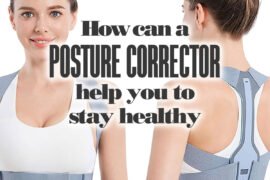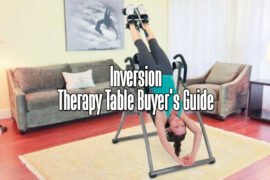Posture correctors are also known as posture supporters or posture braces. When answering this question, you should bear in mind that the shape of our spine and our muscles’ tone determines our body’s posture.
For most people, they are able to maintain an upright and perfect posture. However, some individuals are not able to maintain it. The reason could be one of the many factors.
For instance, it could be caused by muscle problems, spinal disease, or the nature of their job, which causes them to sit in a slouched position for long hours in front of their desk.
In these cases, they may need additional support by seeking the services of physical therapists, which includes the support of posture correctors. In this article, we’ll look at posture correctors in detail and how they work.
- Adjustable straps for a customized fit
- Breathable and lightweight materials for comfort
- Posture cueing mechanisms remind the wearer to sit/stand up straight
- Discreet design for wear under clothing
- Reinforcement panels for added support to the back and shoulders
- Improves posture and reduces back pain
- Provides support for weakened muscles
- Enhances confidence and appearance
- Adjustable to fit different body types
- Easy to wear and remove
- It may improve breathing and circulation
- Can cause discomfort or irritation
- May weaken muscles with prolonged use
- Not a substitute for exercise and therapy
Types and Benefits of These Garments: Do Posture Correctors Work?
Table of Contents
In simple terms, a posture corrector or brace is a garment that’s custom designed to offer additional support to your back and shoulders. It also provides stability to the shoulder, neck and back muscles.
Posture braces work by pulling your shoulders backward and straightening your back i.e. by aligning these structures back to their natural position. Women can buy posture support in the form of posture bras.
When Are They Offered to Patients?
Posture correctors are usually prescribed to patients with deformities in their back. These deformities include the spine bending forwards also known as kyphosis, advancing age, and the spine bending sideways, also known as scoliosis.
Other contributing factors include an increase in your body weight, poor posture, and the lack of physical body exercises.
As this article mentioned previously, spending long hours in front of your desk or living a sedentary life can lead to back problems, which posture correctors can help with by reducing the strain on your back.
Patients who have recently suffered whiplash injury can also get posture support. Similarly, those with problems in their intervertebral discs, which lie in between their vertebral bones, can also use this device. A recognized indication that you need this garment is the degeneration of the spine, which can be seen in osteoarthritis.
Types of Posture Correctors
Posture correctors, or braces, come in different sizes and shapes. A specific bra is available for women, which offers them excellent support. Other types of correctors include shoulder straps, belts, and back braces. They support various parts of the spine and can help in the proper positioning of muscles and bones. That’s if they are in an unnatural position.
There are several types of posture correctors that can be used to help improve posture and reduce pain associated with poor posture. These include:
- Back braces: These are worn around the lower back and can help to support the natural curvature of the spine. They are often used to treat conditions such as scoliosis or kyphosis.
- Shoulder posture correctors: These are worn around the upper back and shoulders and help to pull the shoulders back into a natural, upright position.
- Posture vests: These are worn over the upper body and help to support the natural curvature of the spine. They may also have built-in resistance bands to help strengthen the muscles that support proper posture.
- Posture bands: These are worn around the upper arms and help to gently pull the shoulders back into a natural, upright position.
Benefits of Posture Correctors
Benefits of using posture correctors include:
- Improved posture: Posture correctors can help to realign the spine and correct poor posture, which can lead to a more confident and upright appearance.
- Pain relief: Poor posture can lead to muscle aches and pains. Using a posture corrector can help to alleviate these discomforts.
- Increased mobility: Poor posture can limit range of motion and flexibility, but using a posture corrector can help to improve mobility and flexibility.
- Improved breathing: Good posture can help to improve breathing by allowing the lungs to fully expand and contract.
- Better digestion: Good posture can help to improve digestion by allowing the digestive system to function more efficiently.
How to Use a Posture Corrector
The best way of using a posture corrector is first to seek the advice of your doctor. The reason is that the correct posture braces are best recommended by physical therapists. However, these devices are also available online, which means you can still buy and use them on your own.
They fit comfortably, in the same way, you wear your shirt or coat. You can also wear them depending on the duration you need them. However, bear in mind that wearing them for long periods can restrict the movement of your spine. The best way to ensure you obtain a proper posture is to have a good exercise plan and use the best model of a posture corrector.
What to Do When Buying a Posture Brace
Make sure you read online posture corrector reviews before buying them. You need to know how previous users or patients found the model. It also gives you assurances that you’re getting the best value for your money.
Compare prices as you choose among the best brands since they are available at different costs. Keep in mind that your spine is among the most critical areas of your body. It means that you should consider buying the best models that suit your needs.
Remember to seek the advice of your doctor. That’s because only a physician knows what you need for your condition.
Posture braces come in many types, which mean that you need to consider your doctor’s advice to know which models suit you. It avoids instances of you having to repurchase other types; in case you buy one that doesn’t suit you.
Things To Take Care of While Using the Posture Corrector
If you’re using a posture corrector to help improve your posture, there are several things to keep in mind to ensure you use it safely and effectively:
- Choose the Right Posture Corrector: Make sure you choose a posture corrector that fits you properly and is designed to address your specific posture issues.
- Wear it Properly: Make sure you read the instructions carefully and wear your posture corrector properly. It must fit snugly but not be too tight or uncomfortable.
- Gradually Increase Wear Time: Start by wearing the posture corrector for short periods of time and gradually increase the duration as you become more comfortable.
- Don’t Depend on It Completely: Posture correctors are designed to help you improve your posture, but they should not be relied upon completely. It’s also important to incorporate exercises and habits that promote good posture.
- Avoid Overuse: Don’t wear your posture corrector for too long. As this can cause muscle fatigue and even lead to injury.
- Listen to Your Body: If you experience any discomfort or pain while wearing the posture corrector, remove it immediately and consult with a healthcare professional.
- Maintain Good Hygiene: Make sure you keep your posture corrector clean and dry to prevent skin irritation or infection.
By following these guidelines, you can safely and effectively use a posture corrector to improve your posture and reduce discomfort.
FAQs
Q1. Are there different types of posture correctors available?
Yes, there are several types of posture correctors available, including braces, straps, vests, and shirts. Each type provides varying degrees of support and is designed for specific postural issues.
Q2. Who can benefit from using a posture corrector?
Anyone who spends extended periods sitting or standing in front of a computer suffers from back or neck pain, has poor posture, or has suffered an injury to the back or neck can benefit from using a posture corrector.
Q3. Can posture correctors cause any negative side effects?
While posture correctors can be beneficial, they can also cause negative side effects if used improperly or for extended periods. These side effects include muscle weakness, decreased range of motion, and skin irritation.
Q4. How long does it take to see results from using a posture corrector?
The time it takes to see results from using a posture corrector varies depending on the severity of the postural issue and the frequency of use. Some people may see results within a few weeks, while others may take several months.
Q5. Are there any other ways to improve posture besides using a posture corrector?
Yes, there are several ways to improve posture, including practicing good posture habits, engaging in regular exercise to strengthen the back and core muscles, and taking frequent breaks from sitting or standing for extended periods. Additionally, physical therapy or chiropractic care may also help improve posture.
Conclusion
Do posture correctors work? The above informative article should make it easier for you to buy posture braces. Remember to read online reviews and seek medical advice when purchasing them. Keep in mind that they come in many types, which means you need to know which one will posture corrector work best for you.








